Abstract
The thermal desorption was combined with sodium hydroxide to remediate polychlorinated biphenyl (PCB)-contaminated soil. The experiments were conducted at different temperatures ranging from 300 to 600 °C with three NaOH contents of 0.1, 0.5, and 1 %. The results showed that thermal desorption was effective for PCB removal, destruction, and detoxication, and the presence of NaOH enhanced the process by significant dechlorination. After treatment with 0.1 % NaOH, the removal efficiency (RE) increased from 84.8 % at 300 °C to 98.0 % at 600 °C, corresponding to 72.7 and 91.7 % of destruction efficiency (DE). With 1 % NaOH content treated at 600 °C, the RE and DE were 99.0 and 93.6 %, respectively. The effect of NaOH content on PCB removal was significant, especially at lower temperature, yet it weakened under higher temperature. The interaction between NaOH content and temperature influenced the PCB composition. The higher temperature with the help of NaOH effectively increased the RE and DE of 12 dioxin-like PCBs (based on WHO-TEQ).





Similar content being viewed by others
References
Akzinnay S, Bisaro F, Cazin CSJ (2009) Highly efficient catalytic hydrodehalogenation of polychlorinated biphenyls (PCBs). Chem Commun 38:5752–5753
Chen ASC, Gavaskar AR, Alleman BC, Massa A, Timberlake D, Drescher EH (1997) Treating contaminated sediment with a two-stage base-catalyzed decomposition (BCD) process: bench-scale evaluation. J Hazard Mater 56:287–306
Chen T, Li XD, Yan JH, Jin YQ (2009) Polychlorinated biphenyls emission from a medical waste incinerator in China. J Hazard Mater 172:1339–1343
Frame GM (1997) A collaborative study of 209 PCB congeners and 6 Aroclors on 20 different HRGC columns. 1. Retention and coelution database. Fresenius J Anal Chem 357:701–713
Gomes HI, Dias-Ferreira C, Ribeiro AB (2013) Overview of in situ and ex situ remediation technologies for PCB-contaminated soils and sediments and obstacles for full-scale application. Sci Total Environ 445–446:237–260
Hosomi M, Takada M, Taniguchi S, Murakami A (1994) Reaction kinetics of PCB destruction by the base catalyzed decomposition process. Organohalogen Compd 19:453–457
Hu X, Zhu J, Ding Q (2011) Environmental life-cycle comparisons of two polychlorinated biphenyl remediation technologies: incineration and base catalyzed decomposition. J Hazard Mater 191:258–268
Kawahara FK, Michalakos PM (1997) Base-catalyzed destruction of PCBs—new donors, new transfer agents/catalysts. Ind Eng Chem Res 36:1580–1585
Liu J, Chen T, Qi ZF, Yan JH, Buekens A, Li XD (2014) Thermal desorption of PCBs from contaminated soil using nanozerovalent iron. Environ Sci Pollut Res 21:12739–12746
Misaka Y, Yamanaka K, Takeuchi K, Sawabe K, Shobatake K (2006) Removal of PCDDs/DFs and dl-PCBs in MWI fly ash by heating under vacuum. Chemosphere 64:619–627
Miyamura A, Shimmura H, Taniguchi S, Uchida R, Takada M, Toda H, Hosomi M, Murakami A, Rappe C (1998) Remediation of dioxin contaminated soil and degradation of PCDDs and PCDFs by the base catalyzed decomposition (BCD) process. Organohalogen Compd 36:27–32
Pavel LV, Gavrilescu M (2008) Overview of ex situ decontamination techniques for soil cleanup. Environ Eng Manag J 7:815–834
Qi ZF, Chen T, Bai SH, Yan M, Lu SY, Buekens A, Yan JH, Bulmau C, Li XD (2014) Effect of temperature and particle size on the thermal desorption of PCBs from contaminated soil. Environ Sci Pollut Res 21:4697–4704
Schupp DA, Krishnan ER, Huffman GL (1999) A performance history of the base catalyzed decomposition (BCD) process. Remediat J 3:1–11
Takada M, Uchida R, Taniguchi S, Hosomi M (1997) Chemical dechlorination of PCBs by the base catalyzed decomposition process. Organohalogen Compd 31:435–440
Taniguchi S, Hosomi M, Murakami A, Iimura S, Usukura K, Ozawa S (1996) Chemical decomposition of toxic organic chlorine compounds. Chemosphere 32:199–202
Taniguchi S, Miyamura A, Ebihara A, Hosomi M, Murakami A (1998) Treatment of PCB-contaminated soil in a pilot-scale continuous decomposition system. Chemosphere 37:2315–2326
Van den Berg M, Birnbaum LS, Denison M, De Vito M, Farland W, Feeley M, Fiedler H, Hakansson H, Hanberg A, Haws L, Rose M, Safe S, Schrenk D, Tohyama C, Tritscher A, Tuomisto J, Tysklind M, Walker N, Peterson RE (2006) The 2005 World Health Organization reevaluation of human and mammalian toxic equivalency factors for dioxins and dioxin-like compounds. Toxicol Sci 93:223–241
Weber R, Takasuga T, Nagai K, Shiraishi H, Sakurai T, Matuda T, Hiraoka M (2002) Dechlorination and destruction of PCDD, PCDF and PCB on selected fly ash from municipal waste incineration. Chemosphere 46:1255–1262
Xiao Y, Jiang JG (2014) Base-catalyzed decomposition of hexachlorobenzene: effect on dechlorination efficiency of different hydrogen donors, alkalis and catalysts. RSC Adv 4:15713–15719
Xiao Y, Jiang JG, Yang Y, Gao GL (2011) Base-catalyzed destruction of hexachlorobenzene with zero-valent iron. Chem Eng J 173:415–421
Xing Y, Lu Y, Dawson RW, Shi Y, Zhang H, Wang T, Liu W, Ren H (2005) A spatial temporal assessment of pollution from PCBs in China. Chemosphere 60:731–739
Yamasaki N, Yasui T, Matsuoka K (1980) Hydrothermal decomposition of polychlorinated biphenyls. Environ Sci Technol 14:550–552
Acknowledgments
This research work was financially supported by the Major State Basic Research Development Program of China (973 Program) (No.2011CB201500), the National High Technology Research, and the Development Program of China (No.2009AA061304).
Author information
Authors and Affiliations
Corresponding author
Additional information
Responsible editor: Ester Heath
Rights and permissions
About this article
Cite this article
Liu, J., Qi, Z., Zhao, Z. et al. Thermal desorption of PCB-contaminated soil with sodium hydroxide. Environ Sci Pollut Res 22, 19538–19545 (2015). https://doi.org/10.1007/s11356-015-5136-9
Received:
Accepted:
Published:
Issue Date:
DOI: https://doi.org/10.1007/s11356-015-5136-9




